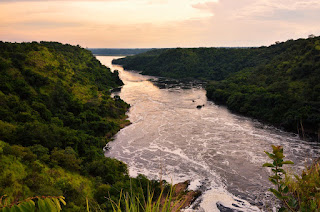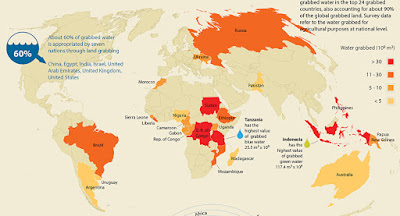Economic and Physical Water Scarcity
Hello! Welcome back to Hydropolitics: Africa Edition. In this post I want to go over the concept of physical and economic water scarcity, to state how countries can have an abundant supply of water but access to this supply is influenced by politics and governmental management strategies.
Africa is the worlds second driest continent. However, the distribution and availability of water is complex, and cannot be narrowed down or applied to the entire continent. Renewable water resources are disproportionately distributed among different regions. Central Africa holds roughly 50% of Africa's total internal water, while northern Africa only contains 2.99% (UNEP, 2010). However, the relative availability of water in different regions does not necessarily correlate with access to safe water. This is a common misconception.
Water scarcity is defined by Damkjaer and Taylor (2017) as a "shortage in the availability of renewable freshwater relative to demand", however, this assumes that 'availability' consists only of water from river runoff and disregards other sources such as groundwater. Physical and economic water scarcity (Damkajaer and Taylor, 2017) are an essential indicator of a countries ability to utilise and access their water resources. Physical water scarcity occurs when there isn't enough water to meet demands which is common in arid and semi-arid regions; while economic water scarcity is when the water resources exist, but there is a lack of investment in technology and infrastructure to make these resources available.
To look specifically at the regions I hope to focus on in this blog, I will use the case of Ethiopia in the East and Algeria in the North. Firstly, Ethiopia is a country that is ranked by the Water Stress Index as sufficient with 1,512 meters squared of renewable water- implying that there is enough quantity of water for the size of the population. However, despite the apparent abundance of water in Ethiopia, only 38% of the population are using an improved source, and 12% are using improved sanitation. This suggests that although there is water for use, the infrastructure and water services don't seem to be sufficient in supplying the population with a suitable water source. According to the Water Atlas ... "more resources have been directed at improving urban water services than towards rural areas and the provision of sanitation"... " about 96% of urban areas had such access although less than 20% of the population resides in cities" (UNEP, 2010). This is a political issue regarding lack of investment or focus on rural populations leaving a large proportion of the population without access to a safe water source.
Algeria, on the other hand, is ranked the second most water scarce country in Africa, with only 339.5 meters squared of renewable water; however 83% of the population has access to improved drinking water sources, and 95% use improved sanitation facilities (UNEP, 2010). To supply water to their growing urban population, they rely heavily on water from the Oranie and Chéli water basins. Additionally, due to their substantial oil and gas revenues, they are able to provide long-distance water transfers at low costs through public-private partnerships, as well as expensive governmental water management programs implementing new technologies to make use of the little water they have available.
To put it simply, the issue of water scarcity is not just physical- it lies partially in the hands of political organisation. Countries that carefully manage their water resources, or invest in water projects as a top priority may be water insecure but are unaffected by water shortages. On the other hand, lack of development or regulation leaves areas with little access to safe water despite there being an abundance. Now that this concept has been drawn upon, I hope it becomes clear why some countries have more control/access to shared water resources over others, it isn't always because they have more water- they may have more efficient governance and the economic/political ability to exert control over resources.
This blog post aimed to share a brief the background of water scarcity and availability in various African countries, as well as an understanding of the role politics plays in providing and distributing water resources to a nation. In my next blog post I will draw on a specific case study underlying transboundary water usage, and the impacts a countries self-interest can have on the other nations sharing such a vital resource.
Africa is the worlds second driest continent. However, the distribution and availability of water is complex, and cannot be narrowed down or applied to the entire continent. Renewable water resources are disproportionately distributed among different regions. Central Africa holds roughly 50% of Africa's total internal water, while northern Africa only contains 2.99% (UNEP, 2010). However, the relative availability of water in different regions does not necessarily correlate with access to safe water. This is a common misconception.
Water scarcity is defined by Damkjaer and Taylor (2017) as a "shortage in the availability of renewable freshwater relative to demand", however, this assumes that 'availability' consists only of water from river runoff and disregards other sources such as groundwater. Physical and economic water scarcity (Damkajaer and Taylor, 2017) are an essential indicator of a countries ability to utilise and access their water resources. Physical water scarcity occurs when there isn't enough water to meet demands which is common in arid and semi-arid regions; while economic water scarcity is when the water resources exist, but there is a lack of investment in technology and infrastructure to make these resources available.
To look specifically at the regions I hope to focus on in this blog, I will use the case of Ethiopia in the East and Algeria in the North. Firstly, Ethiopia is a country that is ranked by the Water Stress Index as sufficient with 1,512 meters squared of renewable water- implying that there is enough quantity of water for the size of the population. However, despite the apparent abundance of water in Ethiopia, only 38% of the population are using an improved source, and 12% are using improved sanitation. This suggests that although there is water for use, the infrastructure and water services don't seem to be sufficient in supplying the population with a suitable water source. According to the Water Atlas ... "more resources have been directed at improving urban water services than towards rural areas and the provision of sanitation"... " about 96% of urban areas had such access although less than 20% of the population resides in cities" (UNEP, 2010). This is a political issue regarding lack of investment or focus on rural populations leaving a large proportion of the population without access to a safe water source.
Algeria, on the other hand, is ranked the second most water scarce country in Africa, with only 339.5 meters squared of renewable water; however 83% of the population has access to improved drinking water sources, and 95% use improved sanitation facilities (UNEP, 2010). To supply water to their growing urban population, they rely heavily on water from the Oranie and Chéli water basins. Additionally, due to their substantial oil and gas revenues, they are able to provide long-distance water transfers at low costs through public-private partnerships, as well as expensive governmental water management programs implementing new technologies to make use of the little water they have available.
 |
| North Africa Post (2017) |
This blog post aimed to share a brief the background of water scarcity and availability in various African countries, as well as an understanding of the role politics plays in providing and distributing water resources to a nation. In my next blog post I will draw on a specific case study underlying transboundary water usage, and the impacts a countries self-interest can have on the other nations sharing such a vital resource.


You have raised some key issues relating to water scarcity and distribution in East and Africa. Perhaps you can provide some more contextual examples of specific 'politics' that have caused these issues to occur. For example are there any policies in place that are contributing to some of the inequalities you have raised? Also you mentioned a large proportion of rural areas do not have access to safe water, how would you define safe water? and are there political factors that influence access to safe water? are there specific countries where rural access is a significant issue ? You are covering really interesting topics, I am looking forward to your future blogs!
ReplyDeleteSorry for the delayed response Marie, thank you for your questions! Some of my more recent blog posts (such as the post about colonial water management on the Nile), go into more detail on specific 'politics' causing issues of economic water scarcity in the sense that there is water available, but current policies favouring downstream regions prevent other riparians from accessing the Niles water supply.
DeleteI would define safe water as water from improved sources (pipe, borehole, well etc), that meets certain chemical standards making it healthy to drink and use for other purposes. The ability for populations to access 'safe water' depends on water infrastructure development, household incomes (often access requires payment which may not be possible for impoverished families), as well as the physical availability of clean water sources. As discussed in my blog posts on the distribution of the Niles waters, it is clear that political frameworks influence the availability of water for various countries.
It is estimated that 8/10 people without access to safe water and sanitation live in rural areas, making rural water provision a large-scale problem throughout Sub-Saharan Africa. Ethiopia is a country facing significant issues in rural water management. 64% of rural households depend on surface water sources- which are highly temporal, water levels drop significantly during the dry season, leaving villages with very few safe alternatives. Ultimately there is little attention on rural water supply - villages are often left to regulate their own access, which often requires drinking from unimproved sources, as limited infrastructure, technology and a lack of skilled workers creates problems surrounding the ability to extract existing water resources.
Good questions Marie! Reply? Do be conscious of precision in quoted numbers - suggesting central Africa holds 50.66% of Africa's internal water belies the huge uncertainty in such a calculation from wherever you sourced this (reference?).
ReplyDelete